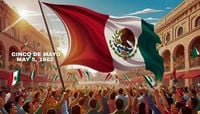AUSTIN, Texas — Cinco de Mayo festivities are taking place across the U.S. on Monday, May 5, 2025, with music, tacos, tequila, and colorful displays of Mexican culture — even if they're not always the most authentic. The day falls on a Monday this year, meaning the bulk of the celebrations took place over the weekend. In California, a state with a large Mexican American population, there was a mix of art displays, classic car shows, parades, and food truck offerings. In Austin, Texas, events included an opportunity for children to get their photo taken with characters from the Disney animated musical “Encanto,” which is itself a celebration of Mexican culture. A luncheon with speakers discussing the significance of the Mexican holiday and Mexican Americans in Austin was planned for Monday.
What the day celebrates Cinco de Mayo marks the anniversary of the 1862 victory by Mexican troops over invading French forces at the Battle of Puebla. The triumph over the better-equipped and much larger French troops was an enormous emotional boost for Mexican soldiers led by Gen. Ignacio Zaragoza. In Mexico, historical reenactments are held annually in the central city of Puebla to commemorate the victory. Participants dress as Mexican and French troops, and as Zacapoaxtlas — the Indigenous and farmer contingent that helped Mexican troops win. In the United States, the date is seen as a celebration of Mexican American culture, stretching back to the 1800s in California. Festivities typically include parades, street food, block parties, mariachi competitions, and baile folklórico, or folkloric ballet, with whirling dancers wearing bright, ruffled dresses and their hair tied with shiny ribbons.
Latino activists and scholars say that disconnect in the U.S. is bolstered by the hazy history of Cinco de Mayo, and marketing that plays on stereotypes that include fake, droopy mustaches and gigantic, colorful sombreros. The day is often mistaken for Mexican Independence Day, which is in September. It’s not all about tequila and tacos. For many Americans with or without Mexican ancestry, the day is an excuse to toss back tequila shots and gorge on tortilla chips, nachos, and tacos. The celebrations in the U.S. started as a way for Mexican Americans to preserve their cultural identity, said Sehila Mota Casper, director of Latinos in Heritage Conservation. “Since then we’ve seen a shift to more commercialization and commodification and mockery over the years,” Mota Casper said. “I think that has a lot to do with the commercialization of products and especially Latino heritage.”
Jacob Troncoza, 49, said he celebrates Cinco de Mayo in his household because he's proud of his Mexican ancestry. “I try to make sure that the kids understand what it’s about, which was the revolution, the war, and the battles that our grandfathers fought on,” said Troncoza, who was born in east Los Angeles. Others, like Andrea Ruiz, don't celebrate because her Mexican dad never did. But she noted what she deemed the irony in widespread celebrations. “I think it’s funny Trump … and all of his supporters want to get Mexicans out, call them criminals, but then on Cinco de Mayo, they want to go and eat tacos and drink tequila,” the 23-year-old Ruiz said.
Political rhetoric has also played a role in how Cinco de Mayo is perceived. Since returning to the White House, Trump has continued to label Mexican immigrants as criminals and gang members. He's also sought to end birthright citizenship, renamed the Gulf of Mexico to the Gulf of America, and ended the federal government's diversity, equity, and inclusion programs. Trump acknowledged Cinco de Mayo during his first term, posting on X, “Happy #CincoDeMayo!” and “I love Hispanics!” as he sat with a “taco bowl.” In the last presidential election, data showed more young Hispanic men moved to the right and voted for Trump. It's unclear if the current administration will acknowledge Cinco de Mayo — designated a holiday in Mexico but not in the United States. The Associated Press sent an email to the White House Press Office late Friday seeking comment.
Trump's handling of immigration remains a point of strength as he ramps up deportations and targets people living in the U.S. without legal status, according to a recent poll from The Associated Press-NORC Center for Public Affairs Research. While Trump’s actions remain divisive, there’s less of a consensus that the Republican president has overstepped on immigration than on other issues, the poll found. Organizers of Chicago's Cinco de Mayo parade said they canceled it because the city has become a target for immigration agents.
In Charlotte, N.C., the atmosphere mirrored that of other cities across the nation. For many Americans, Cinco de Mayo is an excuse to indulge in margaritas and Mexican food, but it also holds significant historic importance. The holiday is often confused with Mexico’s Independence Day, which is celebrated on September 16. Cinco de Mayo commemorates the 1862 Battle of Puebla, where a small Mexican army defeated a much larger French force. This victory was symbolic, showcasing resistance against a European empire attempting to take control of Mexico.
Chicano activists helped raise awareness of the holiday in the 1960s, linking it to a narrative of Indigenous triumph. However, the commercialization of Cinco de Mayo has raised concerns among some about the authenticity of the celebrations. Mario García, a Chicanx historian from UC Santa Barbara, noted that while the victory wasn’t initially celebrated in Mexico, it became a symbol of resistance for Mexican Americans over the years. “It becomes a Chicano holiday, in many ways, linked to the Chicano movement, because we discover Mexicans resisting a foreign invader,” García explained.
In Mexico, Cinco de Mayo is not a major holiday compared to the Independence Day celebrations in September. Schools may close, and some parades take place in Puebla, where the battle occurred. Yet, the holiday has grown in popularity in the United States, particularly in the 20th century, as Mexican-American communities have embraced it to honor their heritage. Silvia Lugo Garcia, who has lived in Mexico her whole life, emphasized, “Our most important celebration is Sept. 16 — that is our Independence Day.”
As the holiday has become more commercialized in the U.S., some have taken issue with the Americanization of Cinco de Mayo. García acknowledges that while he enjoys dining out at Mexican restaurants to celebrate, he believes it’s essential for people to understand the true meaning of Cinco de Mayo and its relevance today. “If people understand the true meaning of Cinco de Mayo, they might think about how it’s applicable to the Hispanic and Latino population today,” he said.
As Cinco de Mayo continues to be celebrated across the United States, it serves as a reminder of the historical significance behind the festivities. While the holiday has evolved into a day of fun and revelry, it also represents a moment of courage and pride in Mexico's history, showcasing the resilience of a nation against foreign domination.





